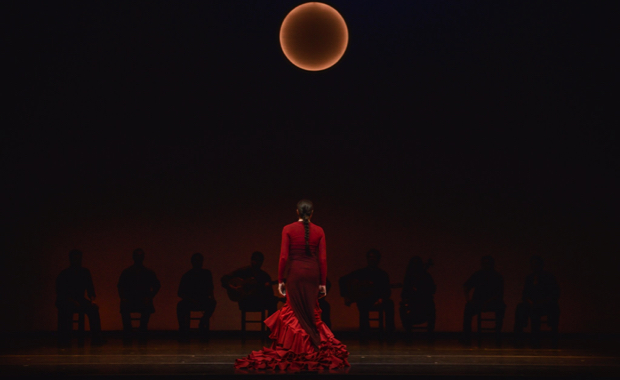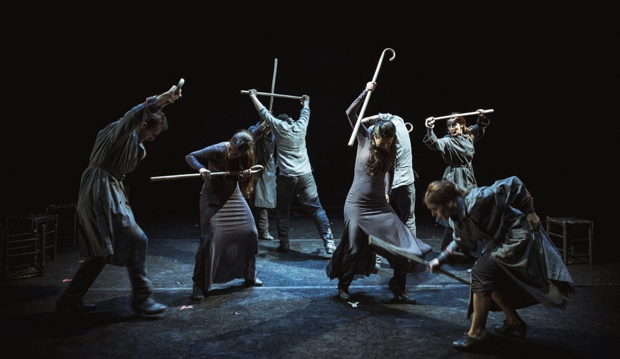Compañía María Pagés, An Ode to Time review ★★★★★
Compañía María Pagés, An Ode to Time. Photo: David Ruano
María Pagés’s An Ode to Time is totally absorbing, a work of many parts that leads you effortlessly on a voyage through Spain’s life and art, its past and our collective present. It wears its many cultural references lightly; it is primarily a stage performance where dance is central. It's all the more exhilarating for that.
The stage is dominated by a large disc of light hanging at the back. A fiery orange to start with, it seems to denote the strong sun of Andalucia, but later, having become a milky white, it oscillates like a pendulum to become a symbol of time. It appears to exert a strong pull over the performers.

Compañía María Pagés, An Ode to Time. Photo: David Ruano
Pagés herself dances the first solo of a piece which is composed of 12 scenes and different styles. Her presence is mesmerising: silver hair tied in a ponytail, her long, svelte body clad in a figure-hugging dark red long dress, she starts with torso swaying, arms undulating like tree branches in the wind. Then she brings in her castanets, their crisp sound entering into dialogue with a guitar. And finally she unleashes a fierce zapateado.
Central as the veteran Pagés is to the show, which she devised along with her husband El Arbi El Arti, her company of five musicians, two singers and eight bailaores are integral to the performance and all are superb artists.
The show combines traditional flamenco styles – bulería, soleá, seguiriyas – with the poetry of Pablo Neruda, and its original music occasionally incorporates a stylised reference to Vivaldi or Handel. One moment a backcloth shaped like the entrance to a cave takes us to the cuevas where flamenco artists gather; the next Pagés leads her company, all sitting on low stools, into a spoken adaptation of Neruda’s poem An Ode to Numbers.
All the traditional flamenco accoutrements are present and correct: castanets, batas de cola in a palette evocative of Goya, colourful mantóns, or shawls, with which the four bailaoras join María Pagés in a dizzying dance. Yet An Ode to Numbers both eulogises and transcends flamenco.
The final sequence is dark and deeply disturbing.

Compañía María Pagés, An Ode to Time. Photo: David Ruano
The dancers are now clad in military grey and simulate killing in a series of graphic tableaux. You are immediately reminded of Spain’s tragic and devastating civil war; and the reference to Picasso’s famous painting in the title of the scene Listening to Guernica bears testimony to the need to remember.
An Ode to Time ends as it started, with a huddle of dancers around Maria Pagés, arms raised to heaven, forming a memory tree. It is a remarkable work, which shows you can bring flamenco into the present while keeping its ancestral vital force intact. it makes for a rousing and hopeful finale to a festival that has had its ups and downs.
The stage is dominated by a large disc of light hanging at the back. A fiery orange to start with, it seems to denote the strong sun of Andalucia, but later, having become a milky white, it oscillates like a pendulum to become a symbol of time. It appears to exert a strong pull over the performers.

Compañía María Pagés, An Ode to Time. Photo: David Ruano
Pagés herself dances the first solo of a piece which is composed of 12 scenes and different styles. Her presence is mesmerising: silver hair tied in a ponytail, her long, svelte body clad in a figure-hugging dark red long dress, she starts with torso swaying, arms undulating like tree branches in the wind. Then she brings in her castanets, their crisp sound entering into dialogue with a guitar. And finally she unleashes a fierce zapateado.
Central as the veteran Pagés is to the show, which she devised along with her husband El Arbi El Arti, her company of five musicians, two singers and eight bailaores are integral to the performance and all are superb artists.
The show combines traditional flamenco styles – bulería, soleá, seguiriyas – with the poetry of Pablo Neruda, and its original music occasionally incorporates a stylised reference to Vivaldi or Handel. One moment a backcloth shaped like the entrance to a cave takes us to the cuevas where flamenco artists gather; the next Pagés leads her company, all sitting on low stools, into a spoken adaptation of Neruda’s poem An Ode to Numbers.
All the traditional flamenco accoutrements are present and correct: castanets, batas de cola in a palette evocative of Goya, colourful mantóns, or shawls, with which the four bailaoras join María Pagés in a dizzying dance. Yet An Ode to Numbers both eulogises and transcends flamenco.
The final sequence is dark and deeply disturbing.

Compañía María Pagés, An Ode to Time. Photo: David Ruano
The dancers are now clad in military grey and simulate killing in a series of graphic tableaux. You are immediately reminded of Spain’s tragic and devastating civil war; and the reference to Picasso’s famous painting in the title of the scene Listening to Guernica bears testimony to the need to remember.
An Ode to Time ends as it started, with a huddle of dancers around Maria Pagés, arms raised to heaven, forming a memory tree. It is a remarkable work, which shows you can bring flamenco into the present while keeping its ancestral vital force intact. it makes for a rousing and hopeful finale to a festival that has had its ups and downs.
TRY CULTURE WHISPER
Receive free tickets & insider tips to unlock the best of London — direct to your inbox
| What | Compañía María Pagés, An Ode to Time review |
| Where | Sadler's Wells, Rosebery Avenue, London, EC1R 4TN | MAP |
| Nearest tube | Angel (underground) |
| When |
01 Jul 22 – 02 Jul 22, 19:30 Dur.: 1 hour 20 mins no interval |
| Price | £15-£65 (+booking fee |
| Website | Click here to book |